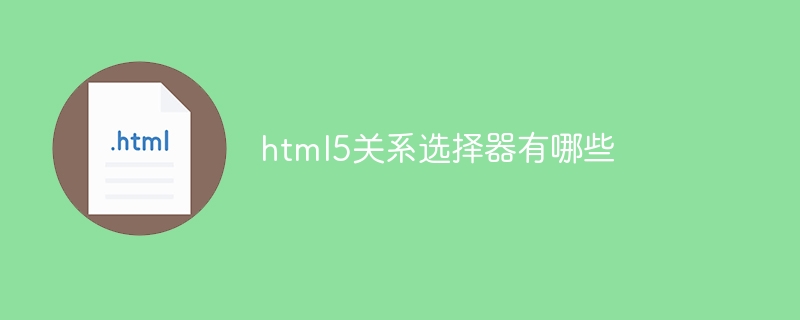
html5 relationship selectors include descendant selectors, child element selectors, adjacent sibling selectors, universal sibling selectors, column selectors, group selectors and :has selectors, etc. Detailed introduction: 1. The descendant selector is used to select the descendant elements of an element. It uses spaces to indicate the relationship between elements. 2. The child element selector is used to select the direct child elements of an element. It uses the greater than sign to indicate it. The relationship between elements; 3. The adjacent sibling selector is used to select the next adjacent sibling element of an element. It uses a plus sign to indicate the relationship between elements, etc.

The operating system for this tutorial: Windows 10 system, DELL G3 computer.
In HTML5, a selector is a mechanism for selecting and positioning HTML elements. In addition to common selectors such as tag selectors, class selectors, and ID selectors, HTML5 also introduces some new selectors, called relational selectors. These relationship selectors can select specific elements based on relationships between them. The following are common relationship selectors in HTML5:
1. Descendant Selector:
The descendant selector is used to select the descendant elements of an element. It uses spaces to indicate relationships between elements.
div p { /* 选择div元素内的所有p元素 */ }
2. Child Selector:
The Child Selector is used to select the direct child elements of an element. It uses the greater than sign (>) to indicate the relationship between elements.
div > p { /* 选择div元素的直接子元素p */ }
3. Adjacent Sibling Selector:
The Adjacent Sibling Selector is used to select the next adjacent sibling element of an element. It uses the plus sign ( ) to indicate the relationship between elements.
h1 + p { /* 选择紧接在h1元素后的p元素 */ }
4. General Sibling Selector:
The General Sibling Selector is used to select all sibling elements after an element. It uses the tilde (~) to indicate the relationship between elements.
h1 ~ p { /* 选择h1元素之后的所有p元素 */ }
5. Column Selector:
The column selector is used to select a column in the table. It uses colon (:) and the nth-child() pseudo-class to represent the index of the column.
td:nth-child(2) { /* 选择表格中的第二列 */ }
6. Group Selector:
The group selector is used to select multiple elements at the same time. It uses commas (,) to separate different selectors.
h1, h2, h3 { /* 选择h1、h2和h3元素 */ }
7. :has selector:
The :has selector is used to select elements containing the specified selector. It can be used to select a parent element that contains a specific child element.
div:has(p) { /* 选择包含p元素的div元素 */ }
These relationship selectors can help developers select and position HTML elements more accurately, making the application of CSS styles more flexible and convenient. By rationally using relationship selectors, you can achieve finer style control and layout effects.
It should be noted that different relational selectors may vary in performance, especially when selecting large documents or complex structures. Therefore, when using relational selectors, it is recommended to reasonably optimize the use of CSS selectors and avoid selectors that are too complex or nested too deeply to improve page performance and response speed.
The above is the detailed content of What are the html5 relationship selectors?. For more information, please follow other related articles on the PHP Chinese website!